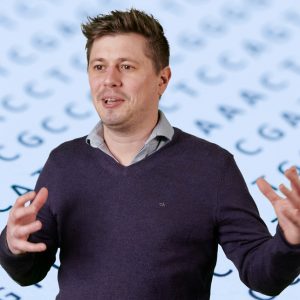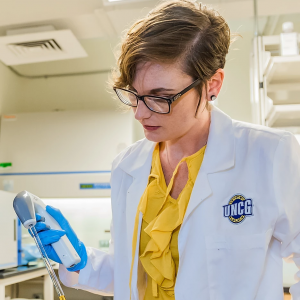Posted on May 1, 2020
In the past two years our highly competitive faculty have been awarded more than $5,000,000 in prestigious research funding from federal agencies like the National Institute of Health, National Science Foundation, and the United States Department of Agriculture. Some examples of recently funded research projects are below.

Dr. Joseph Santin
Acquiring anoxia tolerance in neural circuit function
Our brains need a constant supply of energy to keep us healthy and thinking clearly. When neurons in the brain don’t have enough energy, they cannot continue their normal signaling roles, eventually leading to permanent damage in conditions such as stroke, cardiac arrest, or drug overdose. Likewise, military pilots who fly at high altitudes encounter reduced oxygen and energy levels that cause cognitive failure, often with dire consequences. Many of these pathologies come about when neurons can no longer maintain their normal electrical and metabolic functions, so the ultimate goal for neuroprotection is to shield the brain from insults to avoid downstream damage. Dr. Santin received a grant from the National Institutes of Health to study how to manipulate neurons into a state of resistance to energy stress. His lab uses neurons from frogs that can shift between functioning poorly and completely normal during oxygen deprivation. In essence, these neurons “flip a switch” and become resistant to the devastating effects of energy stress that are so prevalent across many neurological disorders. By identifying the molecular, metabolic, and electrical properties that underlie the switch, this work will uncover how nature has already solved a complicated health problem and open new lines of research with direct relevance to human health. This work will involve undergraduate and graduate students at UNCG and is expected to begin in May. Read more here.

Dr. Louis-Marie Bobay
Investigating the impact and patterns of homologous recombination and adaptive evolution on bacterial genomes.
Dr. Bobay received an NIH Award to study two fundamental aspects of bacterial population genetics that remain remain sorely understudied: 1) the impact of DNA exchange on the evolution of bacterial genomes and populations, which is largely unknown, and 2) the prominence of adaptive evolution, which has not been comprehensively assessed in bacteria. Determining how recombination and adaptive evolution impact bacteria is key to understand the biology of these organisms and to develop relevant models of their evolution. This is a major concern for human health, as exemplified by the microbes’ abilities to transfer virulence and antibiotic resistance genes. Although bacteria reproduce clonally, there is increasing evidence that the vast majority of these organisms are capable of homologous recombination by exchanging pieces of DNA in a process similar to gene conversion in animals and plants. This process enhances microbial capacity to adapt to stresses or changing environments and the exchange of DNA between bacterial strains is a major concern for human health as exemplified by the transfer of virulence and antibiotic resistance genes. Despite the central role of this process, the rates and patterns of recombination remain unresolved in bacteria. Dr. Bobay’s research will support two Ph.D. students, two Masters students, a postdoctoral research scientist, and undergraduate students. Read more here.

Dr. Ramji Bhandari
Correction of endocrine disruptor induced transgenerational epimutations by CRISPR-dCas9
Environmentally induced transgenerational alterations in DNA methylation, also called epimutations, have been demonstrated in mammals and fish. Many of these epimutations have negative consequences. It is not clear if transgenerational epimutations can be inherited by soma and corrected by CRISPR-dCas9 epigenome editing tools in vivo. A successful method to correct transgenerational epimutations in vivo has promising applications in health and disease. Dr. Bhandari uses a fish called medaka to develop such tools to study transgenerational inheritance. He has found reproducible male medaka fish phenotypes with approximately 20-30% reduced fertilization rates at the third generation (F2) after exposure of embryos during the first generation (F0) to birth pharmaceutical estrogen, 17-ethinylestradiol (EE2), suggesting that embryonic EE2 exposure alters programming of developing germ cells. He has received an NIH grant to study genomewide epimutations and to use CRISPR-dCas9 tools to bring new insights into epigenetic mechanisms underlying transgenerational diseases in humans and their therapeutic applications. His research supports a postdoctoral fellow, Ph.D., M.S. and undergraduate students. Read more about it here.

Dr. Kasie Raymann
BEE: Unraveling the ecological and evolutionary factors shaping host–associated microbial communities.
Our understanding of the forces that drive community assembly, composition, and dynamics in bacterial communities is an open question in biology. In large part, this gap in knowledge is because the fields of community ecology and population genetics need to be integrated. Microbes evolve quickly, and microevolution and ecological pressures both impact microbial community structures, and therefore it is imperative that both ecological and evolutionary pressures be considered to learn about bacterial community assembly. Environmental factors, species interactions, and evolutionary dynamics all play a role in shaping communities. However, the relative contributions of each of these factors in driving microbial community composition remain unclear. Dr. Raymann received an NSF grant to conduct studies that aim to bridge ecology and evolution by integrating concepts and approaches from both fields to investigate the forces that govern the composition of host-associated microbial communities. Dr. Raymann’s three main objectives are to determine:
1) how the physical environment impacts microbial community composition
2) the relative role of neutral dynamics versus niche assembly in shaping community structure,
3) how microevolution influences community dynamics and structure over time.
Key to this research is the ability to capture community dynamics at both the species level and the strain level (genomic variants within the same species). Artificially inseminated queen bees will be used to create genetically controlled colonies that will be used for in vivo experiments. Community dynamics will be followed across different controlled environmental conditions in which a host-associated microbial community can develop. Dr. Raymann research supports three Ph.D. students, a Masters student, and many undergraduate students. Read more about her work here.

Dr. Martin Tsz-Ki Tsui
Mercury cycling in forest watersheds
Atmospheric deposition of mercury (Hg) to forested watersheds can be through a combination of wet and dry deposition, with the latter pathway considered to be more important due to enhanced dry deposition to the forest canopy. Thus, alteration of the forest canopy is expected to result in changes in the relative contribution of wet vs. dry deposition as well as the amount of deposited Hg. Once deposited, Hg can be exported by streams and can potentially contaminate downstream ecosystems. A portion of this deposited Hg can be microbially converted to methylmercury (MeHg) under anoxic conditions. MeHg is a potent neurotoxin that can strongly bioaccumulates and biomagnifies in natural food webs, posing a serious threat to natural populations of wildlife and humans. Forest restoration is a common practice for restoring native species, protecting endangered species, and improving ecosystem services. Since there is an intimate relationship between Hg cycling behavior and various properties of forested watersheds (including canopy cover, soil saturation, etc.), it is important to examine if and how forest restoration, a common forest management tool, may affect Hg cycling in forested watersheds. The proposed work will provide a unique chance to test the utility of stable Hg isotopes for tracking atmospheric Hg deposition and Hg methylation and for following uptake of Hg from different sources into the food webs of both managed and unmanaged reference watersheds. Dr. Tsui’s research aims to reveal the extent and effects of forest management on Hg deposition and MeHg production in a forested ecosystem in the southeastern region of North America.

Dr. Sally Koerner
Identifying mechanisms of rangeland drought resilience: management strategies for sustainable ecosystem health
Long-term sustainability of rangeland function is vital for providing food security, as well as maintaining the well-being of ranchers and society. The USDA aims to increase the percentage of land with conservation and management strategies in place to improve or sustain productivity and ecological health. Maintaining healthy plant and soil systems is critical to this goal. However, projected increases in extreme climatic events are currently threatening the health of the nation’s rangelands. Discovering and adopting best management practices for this changing climate is therefore critical to sustain America’s rangeland in the long-term. Dr. Koerner has an NSF funded project to (1) experimentally examine the interactive effects of drought intensity and grazing management in a field setting to determine mechanisms underlying rangeland resiliency in the face of a changing climate, and (2) facilitate implementation of best-management practices through a variety of extension programs including local and regional informal learning series and development of interactive web tools tailored for land managers.
Dr. Koerner’s research will provide a framework for increasing our understanding of drought effects in grassland systems. It will provide a way to monitor the effects of grazing on drought-stricken grassland systems and develop best-practices during and following droughts of varying magnitudes to sustainably manage range cattle production. Such knowledge about the interactions among all of the components of rangeland systems is necessary to promote rangeland sustainability in the face of climate change. Her project supports multiple Ph.D., M.S. and undergraduate students. Read more about her work here.